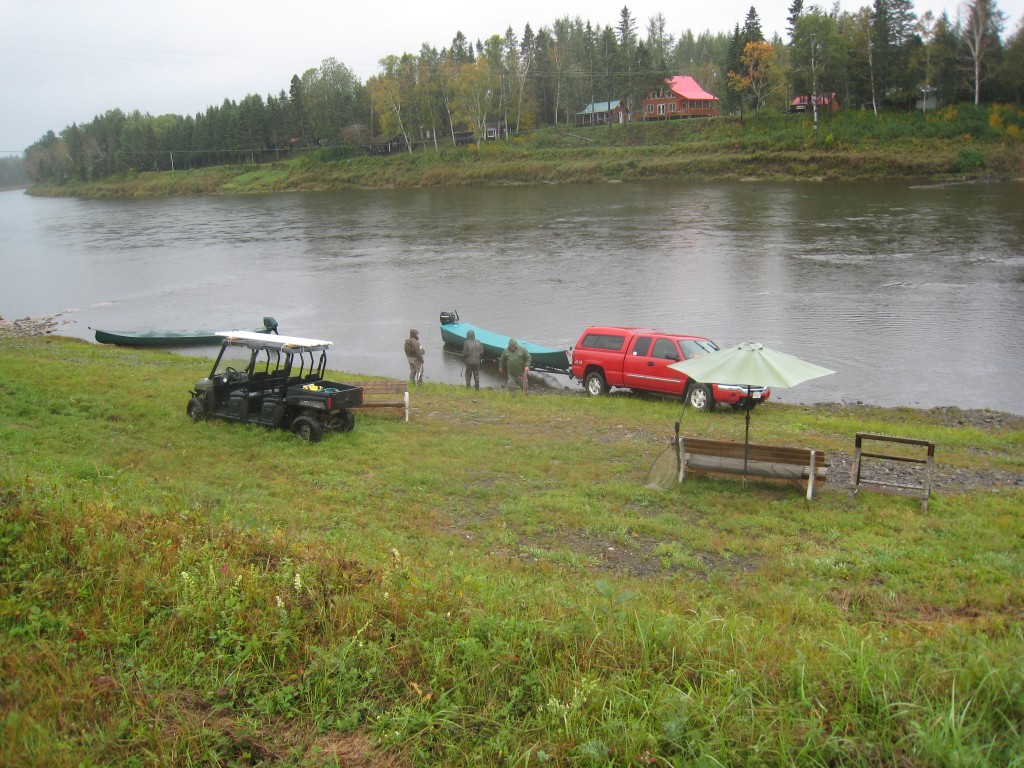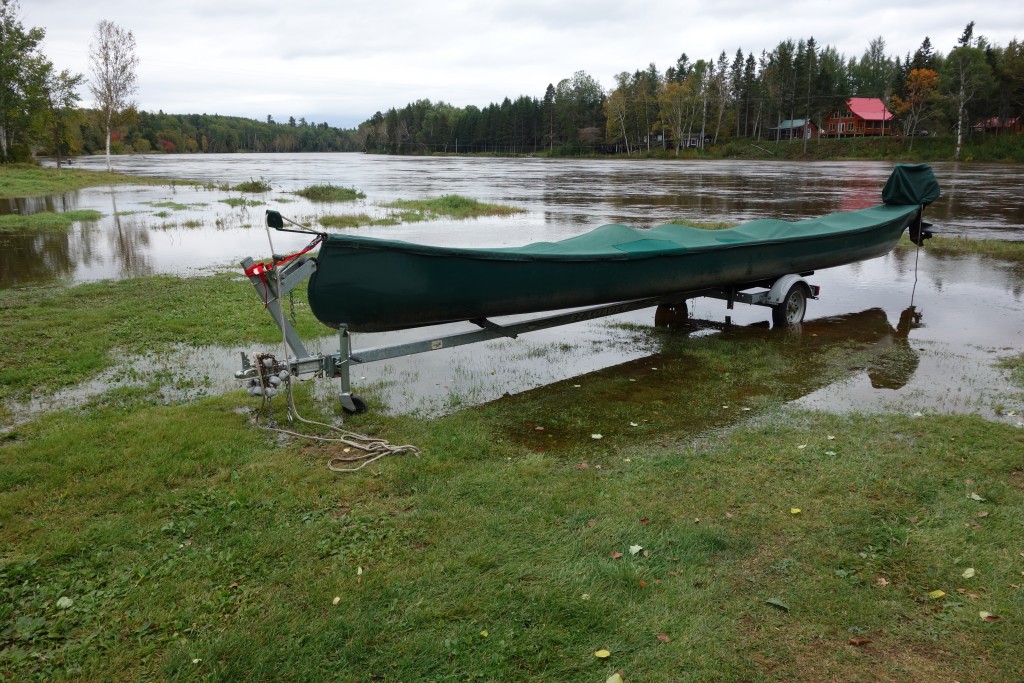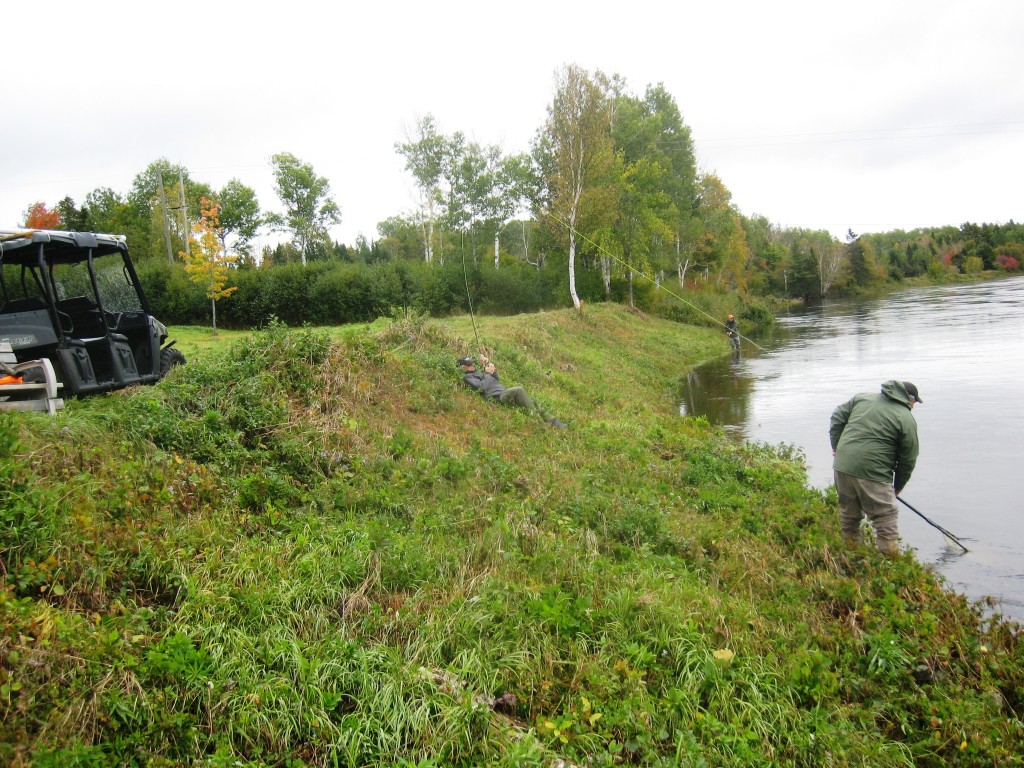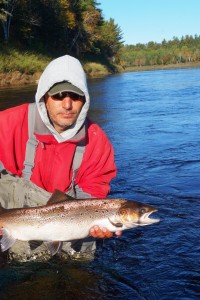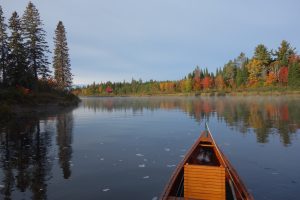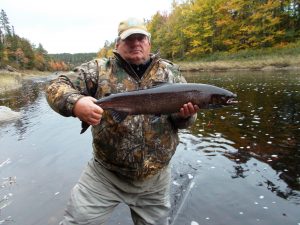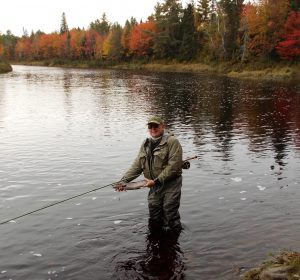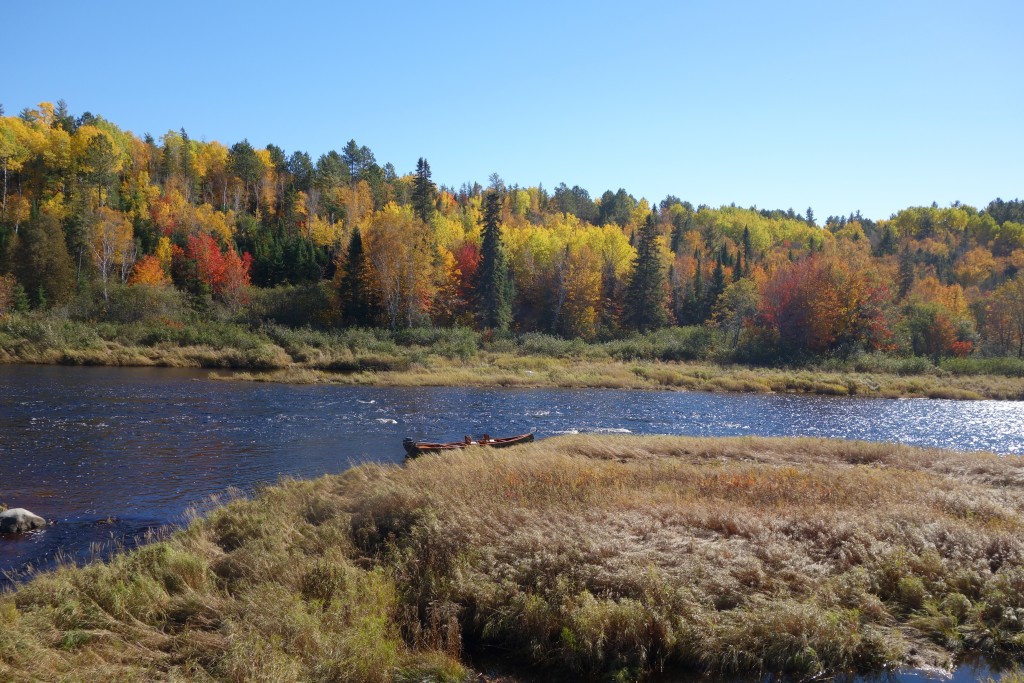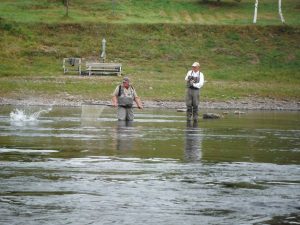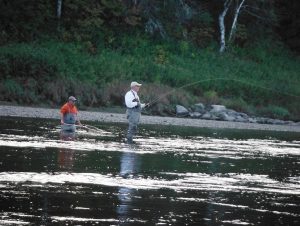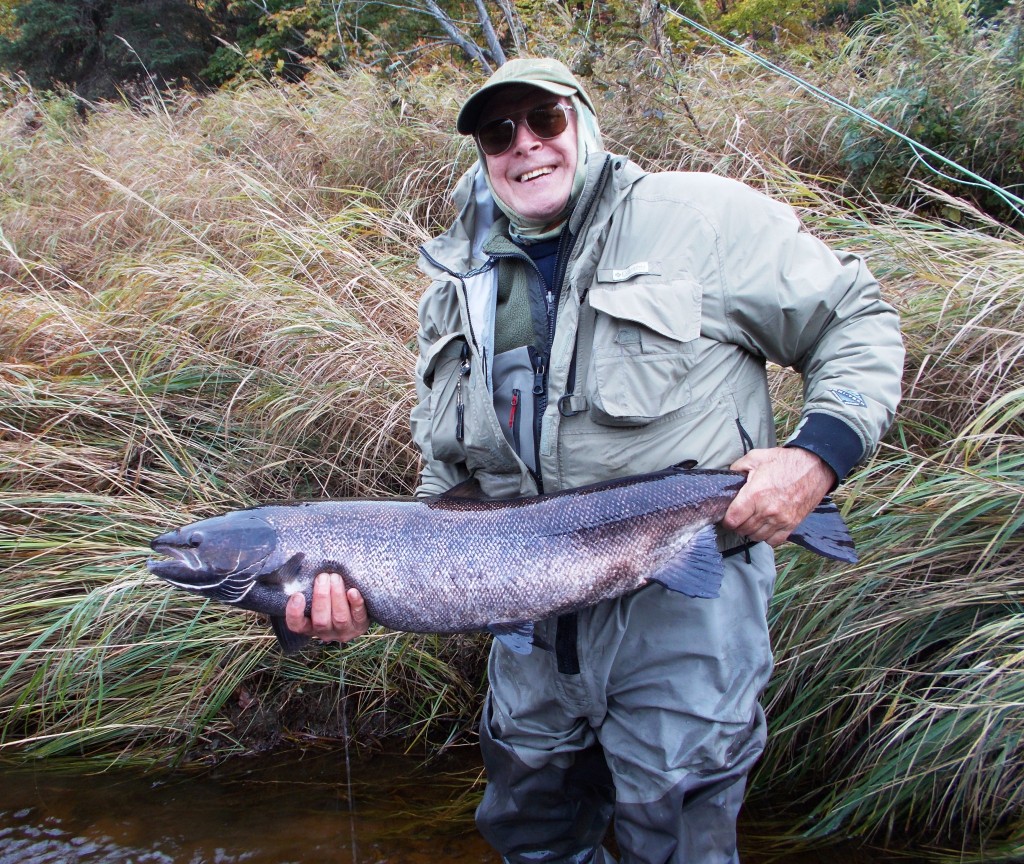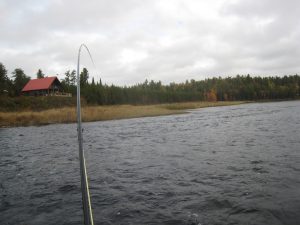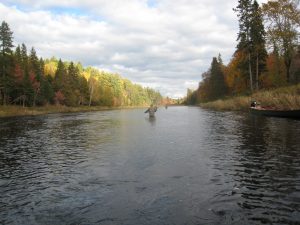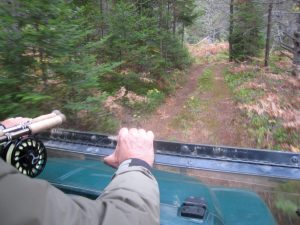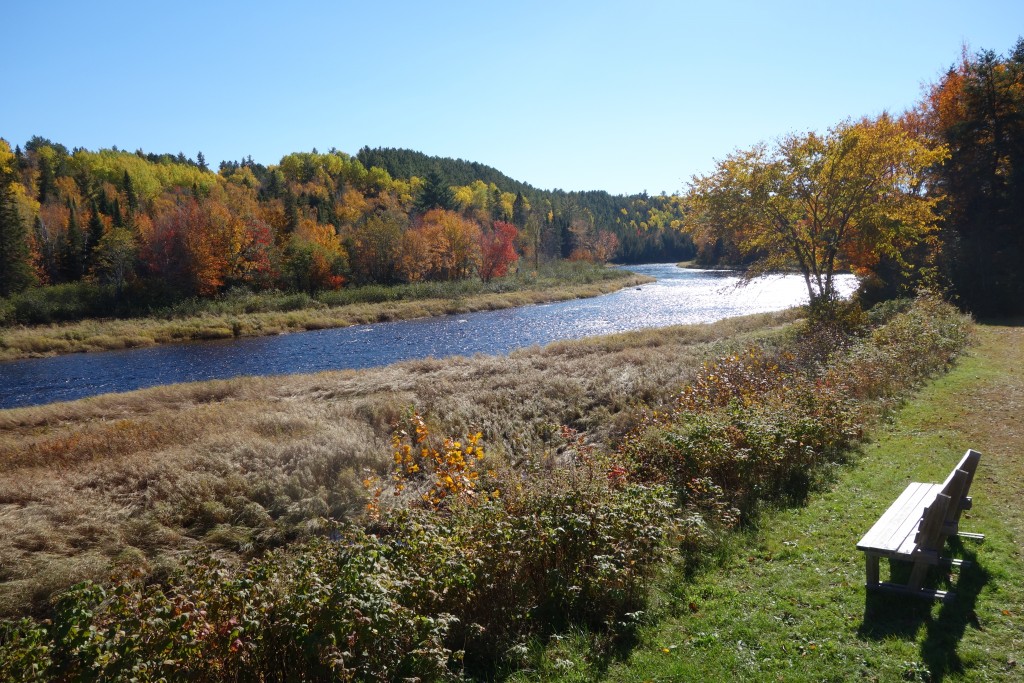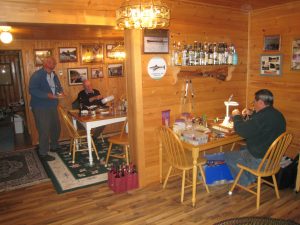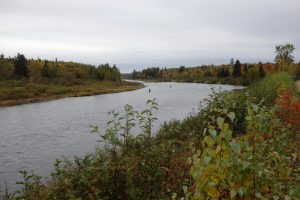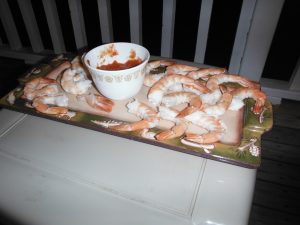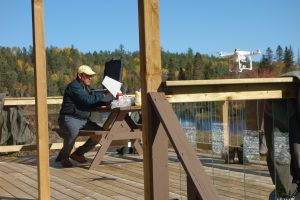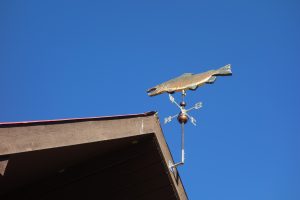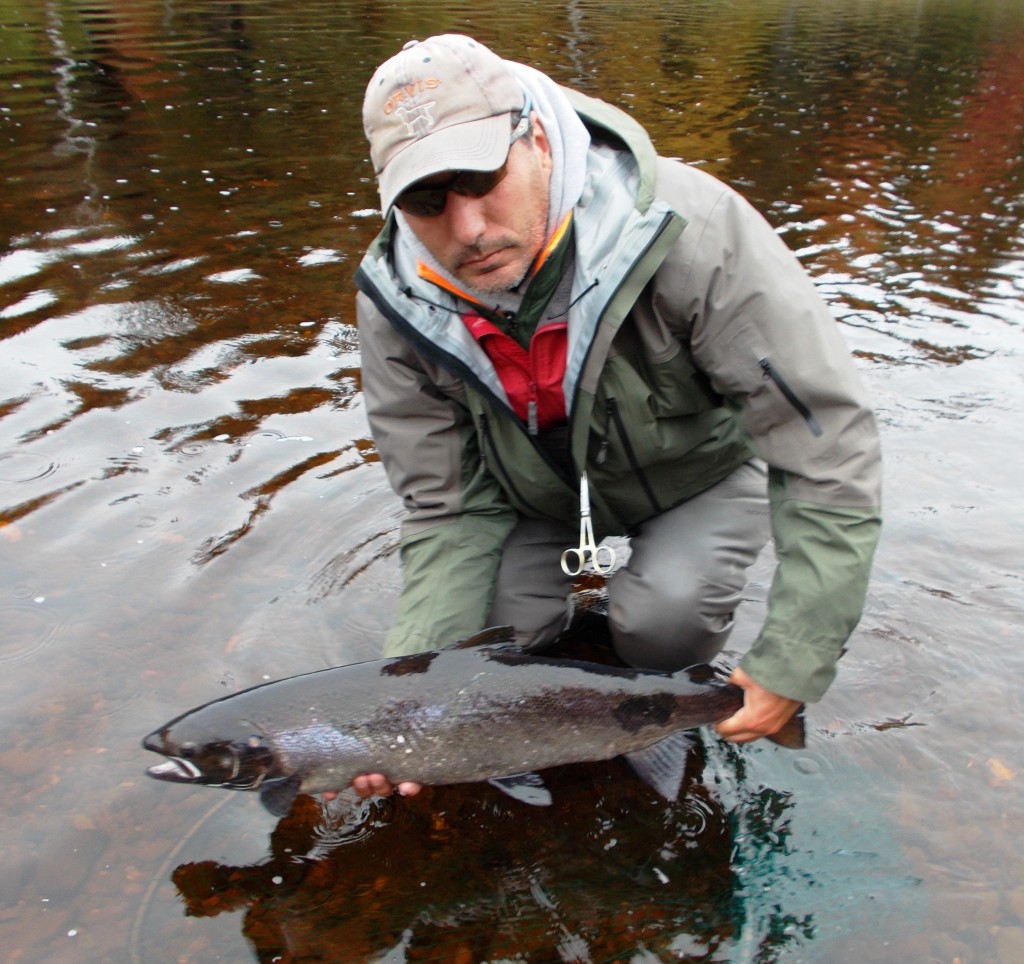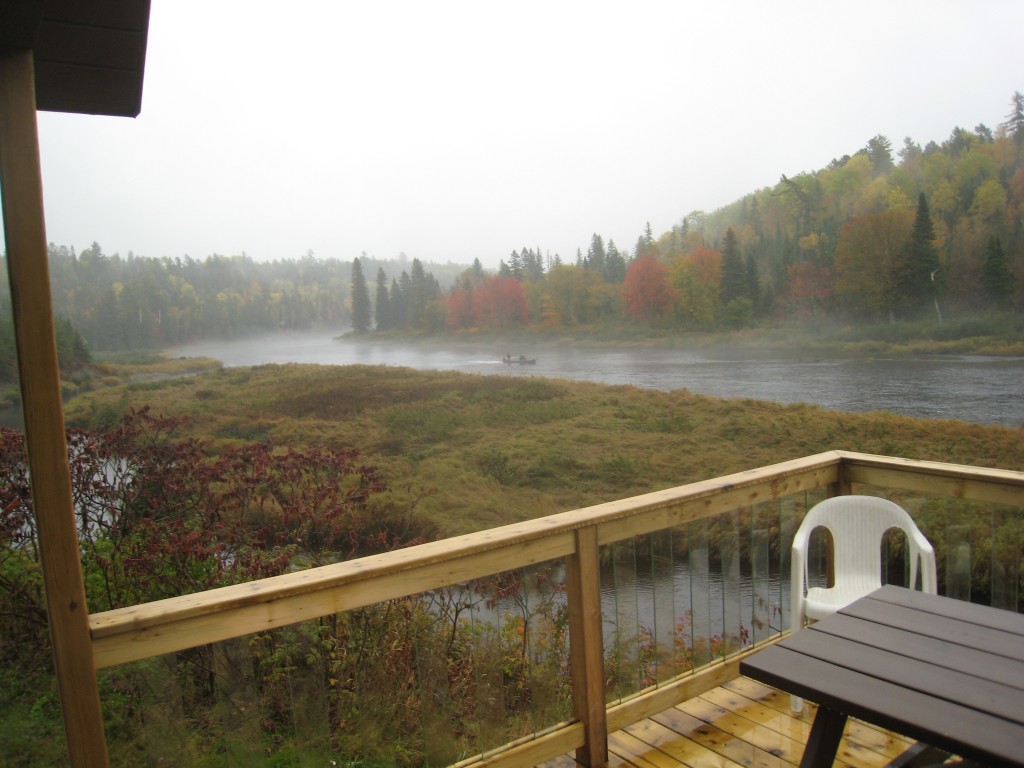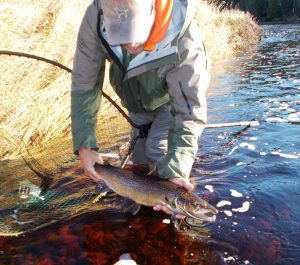
Miramichi and Cains Season Finale
The Miramichi season is now another one for the books, and by all accounts it was far better than any of the previous three seasons. We won’t know exactly how good because just as Hurricane Arthur did in July of 2014 the big rain storm that passed through the Miramich valley on September 29th and 30th brought the river up 21 feet. In advance the government removed the fish traps at Millerton and Cassillis. The water didn’t settle down for several days and the Millerton net was never reinstalled. Single day all time rain records of about 7 inches were set in Fredericton and Miramichi. A reader of this blog who has fished for many years on one of the Cains River’s best pools on the up near Shinnickburn e-mailed me to say that on his arrival at camp, previous to the rain, the water was the lowest he had ever seen. Two days later he said it was the highest.
Note – click on any of the photographs to see full-size, high-resolution shots.
I had never been in camp when the water came up over the edge of the bank into the intervale. It has only done that two or three times in the 13 years I have been at Campbell’s Pool, and previously all these events were either in December or during spring run off. It was really unsettling to see the river become so big and so rapid. I waded around the intervale with a canoe pole and pushed logs back out into the river so I wouldn’t have to remove them later. The river was full of debris. I saw boats, docks, stairs, a wooden bridge and loads of trees headed for Miramichi Bay. The thing that stands out as much as anything in my mind was how fast the river was flowing at the peak of the flood. Trees would come around the corner from upriver a half mile or so away, and in seconds they were rushing past me on their way to the sea. It all seemed like some Hollywood production with the film speed turned way up.
The trap net numbers through September 30th are posted on the government’s website. There is a link to that site on the information page of this website. I’m not sure when the nets were removed, but the September 30th numbers continued to be good, with both salmon and grilse well within historical averages, and considerably above those of recent years. The grilse numbers in particular were roughly equal to the last three years combined, and that is very good. This is purely anecdotal, but I would say that the run after the storm was not quite as strong we might have hoped for, but it was okay, and it continued to the end. Even though we spent virtully all of the last 7 or 8 days up on the Cains we were having cocktails on the deck back in Blackville before dark every evening, and we saw fish rolling on the their way upriver right up to the last evening. We landed salmon with sea lice 20 miles up the Cains on October 14, so clearly fresh fish were still entering the river.
The effects of the huge raise on the late season fishing were very interesting. Unlike most raises the fish did not appear in numbers until several days after the raise backed off. You will see in the pictures included here an angler catching a fish in absurdly high waster. It was just the day after the peak, and I think the gauge was still over 5 meters when Tim Politis fell on his back on the steep
banking. To his credit he kept the rod up and landed the fish. A few minutes later we hooked a fish in exactly the same spot which later turned out to be a big drop off in the road over which we drive down to the shore in low water. In normal water heights those fish would have been swimming through the air, 12 or 14 feet above the surface of the river! Amazing! I ended up assuming that these were just fish that had been caught up in the huge raise the day before as opposed to fresh entries. We didn’t see or hear of another fish for 4 or 5 days. We were afraid the run had ended, but thankfully that was not the case.
The raise of water on the Cains was also dramatic. We lost the new stairs and bench we had built for the Brophy Pool. Even the modestly-sized brook going into our upriver camp rose up and washed out the bridge – see pictures of it with logs stuffed into the hole so we could temporarily get across. 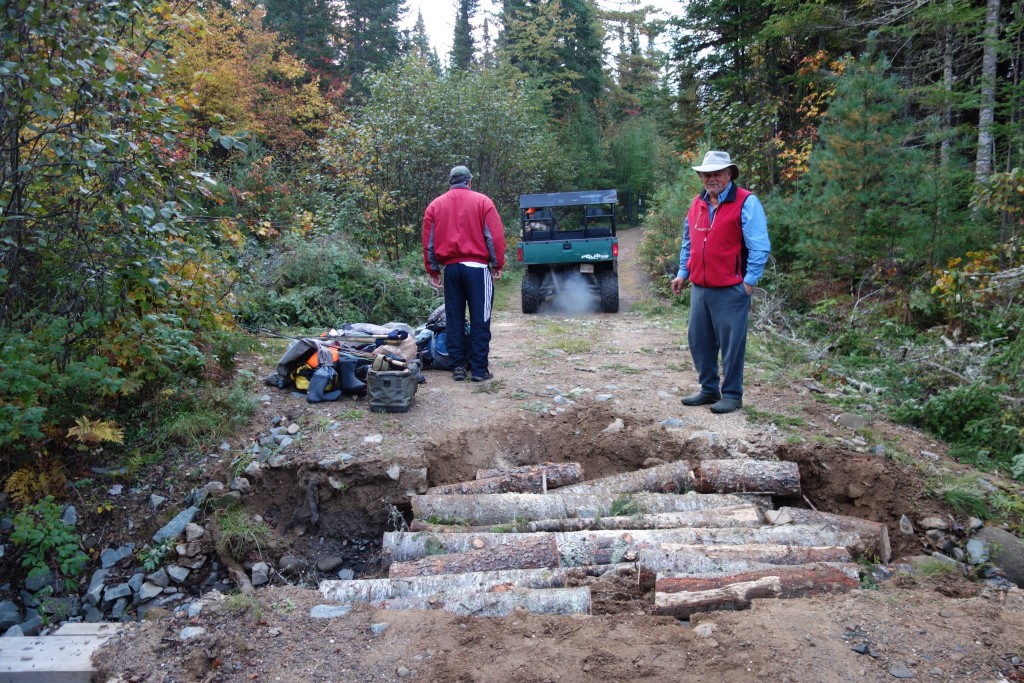 But the Cains is a much smaller water shed and the raise dropped off quickly to fishable levels and clear water. This put fish far up into the river earlier than they have arrived there in most recent years. Three of us landed 21 on the Cains – hooking quite a few more than that – in the last 8 days of the season. Our camp is located 20 miles by water from where the Cains enters the Miramichi. We heard similar good reports from well up beyond us too.
But the Cains is a much smaller water shed and the raise dropped off quickly to fishable levels and clear water. This put fish far up into the river earlier than they have arrived there in most recent years. Three of us landed 21 on the Cains – hooking quite a few more than that – in the last 8 days of the season. Our camp is located 20 miles by water from where the Cains enters the Miramichi. We heard similar good reports from well up beyond us too.
We arrived at Campbell’s on 9/23 to fish the remainder of the season. The next week was categorized by very low water, sunny, fishless days, and modest to fair push of fish that began each evening around 5:30 or so. The fading light brought us opportunities each day, but these fish were mostly stale and we just picked at them with an occasional hookup on a small fly or a bomber. At the end of the week our head guide, Jason Curtis was inducted into the Doaktown Salmon Museum’s Hall of Fame. I attended the ceremony and sat with his family. All the Curtis men at the table: Jason’s uncle Gary, brother Jeff and father Wayne are also New Brunswick guides. Jason’s grandfather was an outfitter on the Cains and Miramichi Rivers and the camps he built to house his sports are now the summer cottages of various members of the Curtis clan.
On 9/29 we awoke to a steady rain, NE wind, and a river just beginning to raise. The beginnings of a raise of water can make for a few hours of exceptional fishing. Fish were coming, though not in the great volumes I have seen during other fall raises. We had already had good pushes of fish during two smaller raises earlier in the month, and with the river being so low there probably were neither a lot of fish holding in the pools downriver from us, nor a lot of fish staged at Quarryville to come up. There was a steady run of fish though. My experience with fishing during the early stages of a raise is that some fish will take a big streamer like my October Killer – pictures and tying instructions in my book Closing the Season. I typically look for a point where a lot of fish are showing, and that has the right characteristics to be a good taking point: point of land, big rock formation, top of a bar, etc. especially one where I have had success before. Then I just keep putting the fly in front of fish. I got just one salmon that day, and briefly hooked a couple of others. Fish hooked during a raise are hard to hold on to because they are not rising from a lie and then dropping back down with the fly neatly in the corner of their jaw. They are swimming along and just opportunistically lashing out at a fly that may be annoyingly close to them – or at least that is what I think is happening. The hookset is often in a marginal spot. You get a few pulls, and an occasional one that can be landed; in a few hours it is over. By mid afternoon the raise was really coming on and fishing was finished. With the exception of the odd-ball that we caught up in the driveway on 10/2 we did not catch another fish in the main river until 10/8. It really took a week for the river to get back into decent shape and the run to resume.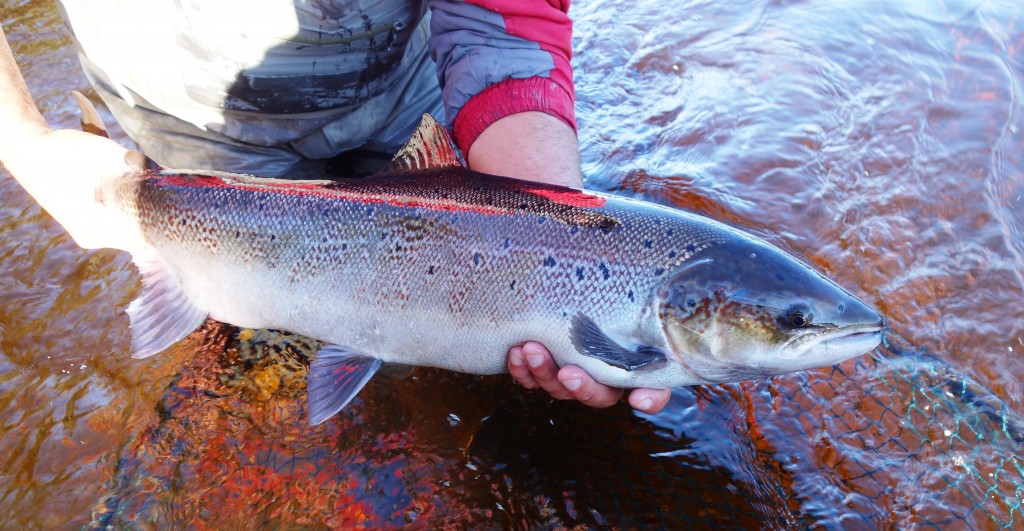 We got our first fish on the upper Cains on 10/5. The river was too deep and strong to wade or fish in most places. I got the fish by standing on top of the grass island near the camp and moving far enough downriver from the camp for the flow to be somewhat diminished. It was until 10/8 that the Cains water was getting down to a good wading level, and we immediately found some of the best fishing there that we have had in the last 5 years. Because of this we spent all our time on the Cains and neglected the main river which we knew still had fish coming in. I stopped at W.W.Doak on my way home on 10/16. Bruce told me that he had reports from anglers fishing just below the Doaktown Rd. bridge over the Cains who had excellent fishing there also. That is about 8 miles further up the river from where we were fishing. Keith Wilson reported as of the 11th, though, that they had yet to see many fish further up the river near the headwaters where his Wildcat camp is located. I’m sure that there is a pile of them up there now on the spawning grounds.
We got our first fish on the upper Cains on 10/5. The river was too deep and strong to wade or fish in most places. I got the fish by standing on top of the grass island near the camp and moving far enough downriver from the camp for the flow to be somewhat diminished. It was until 10/8 that the Cains water was getting down to a good wading level, and we immediately found some of the best fishing there that we have had in the last 5 years. Because of this we spent all our time on the Cains and neglected the main river which we knew still had fish coming in. I stopped at W.W.Doak on my way home on 10/16. Bruce told me that he had reports from anglers fishing just below the Doaktown Rd. bridge over the Cains who had excellent fishing there also. That is about 8 miles further up the river from where we were fishing. Keith Wilson reported as of the 11th, though, that they had yet to see many fish further up the river near the headwaters where his Wildcat camp is located. I’m sure that there is a pile of them up there now on the spawning grounds.
Our catch that last week on the Cains broke down to 15 grilse and 6 salmon. This is also about the same ratio as for the rest of the season, and also to the breakdown in the Millerton trap counts. Interstingly the keen eyes of Jason Curtis noted that two of what we believed to be grilse were females. I’m told by the biologists that almost all the female grilse come very early in the season. I suppose those fish could have been sitting in Black Brook or the Brophy Pool since June waiting for their time. Among the salmon were no record breakers, but in the photos here you will see that Bill Utley is smiling broadly with a very nice hen taken on 10/11 from the Slow Pool. We put 25 pounds in the book, but it could have been a bit more than that. Some of you will recall seeing his picture in Closing the Season fishing the Slow Pool during an unusually cold October morning. While most anglers aren’t anamored with slow moving water the Cains run loves these deep slow pools in the late season. Bill has developed flies, techniques, and a mental attitude that allows him to be productive and enjoy the challenge of fishing this type of water. I will only devulge that sinking tips and long flowing flies are often a standard part of his approach.
On the last day we landed just one grilse, but we hooked up to 4 other fish that came unbuttoned. There was a bit more of that this year than usual, and I would have to lay it on debarbed single hooks. If it helps save parr and the occassional salmon then it is worth it, but I sure would like to have seen a few of the ones that got away during the season. Beyond that we enjoyed some of the nicest weather I’ve had to fish in during the late season. There were more sunny days than I would liked from a fishing perspective, but the fall scenery and comradery back at the camp with my guests during the last month made it all add up to another great year end.
After the trap numbers are all finalized and things quiet down a bit I’ll do a wrap up on the season overall. Please pass this report on to your fishing friends and encourage them to sign up on the website to continue receiving it. If you have any questions don’t hesitate to shoot me an e-mail. Thanks for reading this report. Brad
Here are a few extra photos from the closing days of the 2015 season.
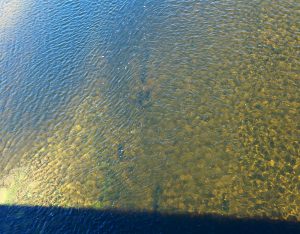
Before the big raise these salmon were holding downstream of Upper Blackville bridge over the Main Southwest Miramichi
PS To unsubscribe just send me an e-mail.


